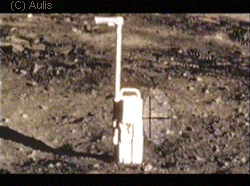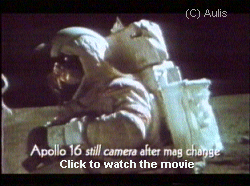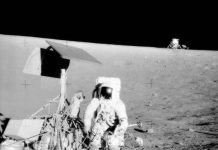Anomalies with the film footage!

Hasselblad were the manufacturer of the camera that took all of the photos on the Apollo missions. Jan Lundberg was the Manager Of Space Projects at Hasselblad from 1966 to 1975 and responsible for the production and building of the Hasselblad 500 EL/70 cameras that were used on the Apollo Missions. He says ‘Originally NASA made all the alterations themselves, then they presented what they had done to us and asked if we could do the same, to which we replied yes we can, and we can do it better. We proceeded to make the alterations that were accepted by NASA.’ Protective plates were added to the case and film magazine.
An important factor to take into consideration is the great variations in temperature that the film would have had to endure whilst on the lunar surface. The temperature during the Apollo missions were recorded as being between -180F in the shade to an incredible +200F in full Sunshine. How could the film emulsion have withstood such temperature differences? The astronauts can be seen to move between the shadows of the rocks and then into full sunlight in some shots. Surely the film would have perished under such conditions? If the film used during the Apollo missions had such qualities as to withstand such differences in temperature, why are Kodak not publicly selling them in today’s market?
|
|
On all Apollo footage there should be cross hairs or reticules present on the film. These crosshairs were, according to NASA, placed on the film to help calculate distances on the Moon. The crosshairs were actually built into the camera and therefore should be visible on every single picture taken by the astronauts on the surface of the Moon. Incidentally, Jan Lundberg has stated that the only way that you could calculate the distance in the shot using the crosshairs would be if you had two cameras set up to take a stereo picture! |
|
Take a look at the pictures presented here and you will see that parts of the crosshairs have disappeared from the film. This is impossible unless the film has been tampered with. The crosshairs should be completely visible in all shots and not hidden behind objects in the pictures. The only solution must be that NASA has gone to the trouble of either airbrushing out certain objects in the film, or added them over the crosshairs! |
|
|
|
Why does this rock have a letter ‘C’ on it? There is also a ‘C’ on the ground in front of the rock. The use of the letter C on film props is well known by the people in Hollywood and is used to show where the centre of the scene should be. One sceptic on the Bad astronomy sceptics web group has even said it is a hair??? on both the rock and ground? Now who’s trying to cover things up? |
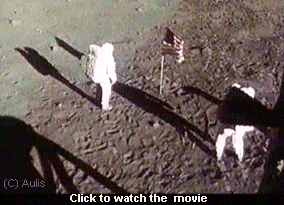
One of the biggest anomalies that appear on the Moon shots are the way in which shadows seem to be cast in totally different directions, even when the objects making the shadows are a mere few feet apart? A classic example can be viewed by clicking the picture to the right. If the guy on the left was near a vertical rise of ground (as has been suggested) his shadow would show a definite ‘crease’ where the land begins to rise. It doesn’t!
Question:
How can an astronaut cast a shadow several feet taller than hiscolleague who is standing a few feet away from him?
Answer:
He is standing farther away from the arc light that is illuminating them both. I truly believe that this footage is taken on a film set, you cannot reproduce this strange shadow phenomenon with natural light, and that includes taking into consideration two natural light sources (the Earth and Sun) as many sceptics would have you believe.
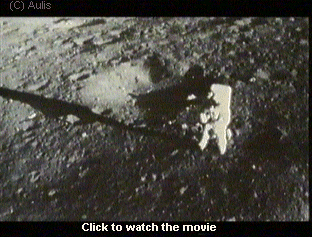
The video on the left contains film footage from the Apollo 11, 12 and 14 missions that would suggest that there are many light sources lighting the so-called Moon’s surface. In the Apollo 11 film the shadow cast by Armstrong is strange, the sun angle is estimated at 10 degrees above the horizon. Now compare it with the Apollo 12 footage that shows a longer shadow. The sun is at a 15 degree angle and so therefore the Apollo 12 shadow should have been shorter. In the Apollo 14 footage look at the shadow as it does some truly amazing manoeuvres! this is consistent with moving away from a source of light that is close to the astronauts.
I have had quite a few debates on the web about the picture above and the others on this page. I’m told by sceptics that the picture appears as it does because you have to remember that two light sources are present on the Moon’s surface (the Sun and Earth glow). I do not doubt that there could be reflective light from the Earth, but, in my opinion, if a light is bright enough to light up this astronauts suit, it is sure capable of also producing another shadow behind him… Sceptics believe that he is illuminated by light reflecting off the Moon’s surface. As I’ve stated elsewhere on this page, the reflectivity is only 7% so the theory of the light bouncing from the surface is highly suspect. If this were the case, the rock on the left of the picture would have hardly a shadow because it is closer to the source where the light is reckoned to be reflecting from!
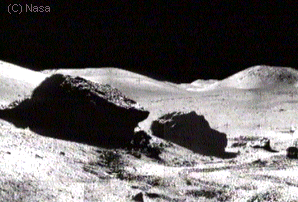
During the Apollo missions, the movie cameras were fitted with special night lenses tocompensate for the lack of light. Due to the atmospheric conditions on the Moon’s surface,only 7% of light is reflected from the ground (that’s the same reflectivity as asphalt). So,taking this into consideration, how did the Hasselblad stills camera manage to pick up moredetail than the movie cameras? NASA have confirmed that no artificial lighting was used on the Moon’s surface, so how can the stills camera take pictures that were brighter and sharper than the movie cameras that were fitted with special lenses to compensate for the dark conditions? The picture to the right shows you just how dark a place the Moon is Look how dark the shadows are on the side of the rocks.

Watch the film sequence to the left that has both movie and still pictures to compare the difference. It’s interesting to note that the still photos seem to have Aldrin brightly lit, in comparison to the gloomy motion picture images that had the special night lens on it? It appears that artificial lighting was used or has been added to the still photos to show better features on Aldrin’s suit and the Lunar Lander. Because of the lack of atmosphere on the surface of the Moon, the shadows would be intensely black. As illustrated in the above motion picture, why is there such a vast difference in the light from the two cameras, unless the still shots were lit by artificial lighting? NASA have said that no lighting was taken to the Moon, but this cannot be true when you view the evidence. The still pictures seem to show that Aldrin is being artificially lit as he descends the ladder.
The reflectivity of the Lunar surface is so low, that light does not even reflect onto the rocks that are on the ground, yet the light in these pictures are so intense, even Aldrin’s heel protector on his boot is lit up! Dr. David Groves who works for Quantech Image Processing has done some analysis of these particular shots and has used resources to pinpoint the exact point at which the artificial light was used. Knowing the focal length of the camera’s lens and being able to get hold of an actual boot, he has calculated that the artificial light source is between 24 and 36 cm to the right of the camera. If the TV footage is actually real, then I could understand this, as the movie images are very dark and grainy, but I believe that the still photographs are definitely faked. 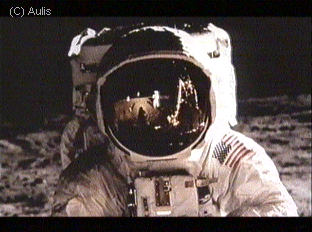
Lets move onto the famous picture of Buzz Aldrin that shows the LEM, Neil Armstrong and landing site in the reflection of his visor. One of the strange things with this picture is that the reticule that is supposed to be in the middle of the picture actually shows up at the bottom of Aldrin’s right leg? How can this be when the camera is attached to the cameraman’s chest??? A fact that is easily verifiable by the reflection of the cameraman in the visor.
Many people have speculated that the pictures have been retouched to bring up the detail of the astronauts. But this cannot be applied to the Apollo 11 photographs because a duplicate copy of the original Armstrong film has been analyzed and shows that the pictures are all on one continuous roll of film that contains over 100 images. Even Jan Lundberg from Hasselblad, the makers of the camera, says that the pictures seem as though Armstrong is standing in a spotlight. The only way the reticule could appear in the bottom of the leg is if the picture had been copied and reframed!!!


The horizon is about 89 degrees from the true vertical. Dr Groves has worked out that after analysing the shadows cast by both the astronaut in the picture and the supposed cameraman in the visor, that Armstrong who is taking the picture is standing on ground that is a mere few inches higher than where Aldrin is stood, If this is the case, then it means that whoever took the shot was in fact at least 2 feet higher than Aldrin and therefore means that Armstrong, although visible with the camera in the visor, is not the actual person who took the shot.
During Apollo 12, one of the cameras suffered a malfunction after the lens had been pointed towards the Sun. As you can see from the sequence here, although the viewing public were told at the time that the camera had burnt out, the lens is still working? the camera didn’t actually burn out at all. The very same thing happened on Apollo 15 where the camera’s lens didn’t burn out. It is interesting to note that during the Apollo 16 mission, one of the astronauts who was being told by Houston to adjust the camera asked if he should point the camera towards the Sun?? even though the manual from the camera specifically points out not to do this? You may be interested to see what the astronauts say on this film while this camera fiasco was taking place.
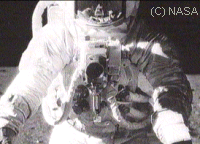
We have to remember that the camera used didn’t actually have any viewfinder, and the astronauts could not see the whole of the camera that was strapped to their chests due to the restrictions posed by their spacesuits. They had to use their body to point in the rough direction of their subject. The astronauts even had to change the lens whilst stood outside on the lunar surface, wearing their heavy gloves. A feat that is quite hard to believe considering the very awkward pressurized gauntlets that they were wearing. The precaution of changing the film inside the LEM was not adhered to and could have ended in disaster if the film had actually been dropped into the dust on the ground. And what about the exposure to the heat?
It would have been virtually impossible to change the film and adjust the lenses in such apparatus. However in certain films, they do seem to be wearing different gloves that do not seem to be pressurized?
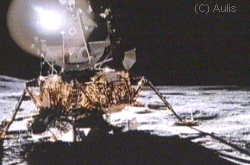
How can we see so much detail on the gold portion of the Lunar Lander in this picture? As is evident by the shadow in front of the module, the Sun is in the background and the gold area should be covered with shadow, not Sunlight? And why does the ‘Sun’ have a halo around it if the Moon has no atmosphere?


